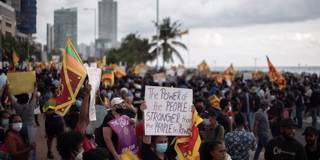In response to acute food and energy shortages and sharply rising inflation, Sri Lankans took to the streets this summer and ousted the strongman whom they had elected just two and a half years ago. They now have an opportunity to craft a new social contract, but only if they act fast.
WASHINGTON, DC – In a win for democracy, mass protests in Sri Lanka recently led to the resignation of President Gotabaya Rajapaksa and Prime Minister Mahinda Rajapaksa. A strongman who won popularity for overseeing the end of Sri Lanka’s civil war in 2009 (while his older brother, Mahinda, was president), Gotabaya was elected in November 2019 and promised to safeguard national security and deliver prosperity. He failed miserably.
Despite allegations of corruption, war crimes, and attacks on journalists, the Rajapaksa government had a powerful mandate, which was reinforced nine months later when the brothers’ party, Sri Lanka Podujana Peramuna (the Sri Lanka People’s Front), won a two-thirds majority in Parliament. Yet during his short tenure, the Rajapaksas drove the country into bankruptcy, food insecurity, and spiraling inflation.
Gotabaya announced his candidacy just days after the 2019 Easter Sunday bombings, promising a strong response to terrorism. In the months that followed, newspapers’ and radio stations’ frenzied coverage heightened people’s fear of Muslims (who comprise 10% of the population), and attacks on them increased. Gotabaya capitalized on this environment, portraying himself as a defender of the Sinhala-Buddhist majority who would transform Sri Lanka into a Singapore of the Indian Ocean. The clergy, media, military, political elites, and local business tycoons all adopted the same rhetoric, tying their fortunes to his.

WASHINGTON, DC – In a win for democracy, mass protests in Sri Lanka recently led to the resignation of President Gotabaya Rajapaksa and Prime Minister Mahinda Rajapaksa. A strongman who won popularity for overseeing the end of Sri Lanka’s civil war in 2009 (while his older brother, Mahinda, was president), Gotabaya was elected in November 2019 and promised to safeguard national security and deliver prosperity. He failed miserably.
Despite allegations of corruption, war crimes, and attacks on journalists, the Rajapaksa government had a powerful mandate, which was reinforced nine months later when the brothers’ party, Sri Lanka Podujana Peramuna (the Sri Lanka People’s Front), won a two-thirds majority in Parliament. Yet during his short tenure, the Rajapaksas drove the country into bankruptcy, food insecurity, and spiraling inflation.
Gotabaya announced his candidacy just days after the 2019 Easter Sunday bombings, promising a strong response to terrorism. In the months that followed, newspapers’ and radio stations’ frenzied coverage heightened people’s fear of Muslims (who comprise 10% of the population), and attacks on them increased. Gotabaya capitalized on this environment, portraying himself as a defender of the Sinhala-Buddhist majority who would transform Sri Lanka into a Singapore of the Indian Ocean. The clergy, media, military, political elites, and local business tycoons all adopted the same rhetoric, tying their fortunes to his.